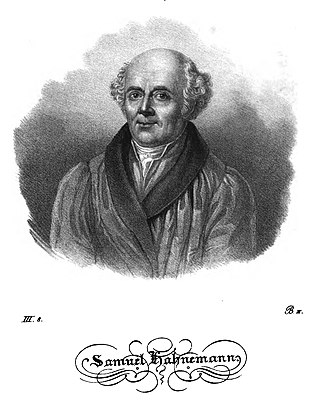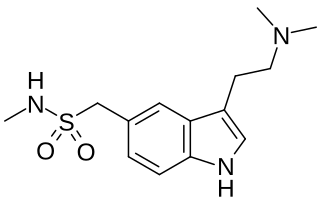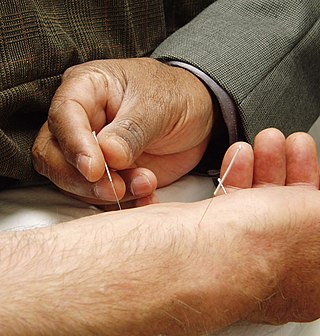Related Research Articles

Homeopathy or homoeopathy is a pseudoscientific system of alternative medicine. It was conceived in 1796 by the German physician Samuel Hahnemann. Its practitioners, called homeopaths or homeopathic physicians, believe that a substance that causes symptoms of a disease in healthy people can cure similar symptoms in sick people; this doctrine is called similia similibus curentur, or "like cures like". Homeopathic preparations are termed remedies and are made using homeopathic dilution. In this process, the selected substance is repeatedly diluted until the final product is chemically indistinguishable from the diluent. Often not even a single molecule of the original substance can be expected to remain in the product. Between each dilution homeopaths may hit and/or shake the product, claiming this makes the diluent "remember" the original substance after its removal. Practitioners claim that such preparations, upon oral intake, can treat or cure disease.

Migraine is a genetically influenced complex neurological disorder characterized by episodes of moderate-to-severe headache, most often unilateral and generally associated with nausea and light and sound sensitivity. Other characterizing symptoms may include nausea, vomiting, cognitive dysfunction, allodynia, and dizziness. Exacerbation of headache symptoms during physical activity is another distinguishing feature. Up to one-third of migraine sufferers experience aura: a premonitory period of sensory disturbance widely accepted to be caused by cortical spreading depression at the onset of a migraine attack. Although primarily considered to be a headache disorder, migraine is highly heterogenous in its clinical presentation and is better thought of as a spectrum disease rather than a distinct clinical entity. Disease burden can range from episodic discrete attacks, consisting of as little as several lifetime attacks, to chronic disease.

Acupressure is an alternative medicine technique often used in conjunction with acupuncture or reflexology. It is based on the concept of life energy, which flows through "meridians" in the body. In treatment, physical pressure is applied to acupuncture points, or ashi trigger points, with the aim of clearing blockages in these meridians. Pressure may be applied by hand, by elbow, or with various devices.

Headache, also known as cephalalgia, is the symptom of pain in the face, head, or neck. It can occur as a migraine, tension-type headache, or cluster headache. There is an increased risk of depression in those with severe headaches.

A placebo can be roughly defined as a sham medical treatment. Common placebos include inert tablets, inert injections, sham surgery, and other procedures.
In a blind or blinded experiment, information which may influence the participants of the experiment is withheld until after the experiment is complete. Good blinding can reduce or eliminate experimental biases that arise from a participants' expectations, observer's effect on the participants, observer bias, confirmation bias, and other sources. A blind can be imposed on any participant of an experiment, including subjects, researchers, technicians, data analysts, and evaluators. In some cases, while blinding would be useful, it is impossible or unethical. For example, it is not possible to blind a patient to their treatment in a physical therapy intervention. A good clinical protocol ensures that blinding is as effective as possible within ethical and practical constraints.

Smoking cessation, usually called quitting smoking or stopping smoking, is the process of discontinuing tobacco smoking. Tobacco smoke contains nicotine, which is addictive and can cause dependence. As a result, nicotine withdrawal often makes the process of quitting difficult.

Tension headache, also known as stress headache, or tension-type headache (TTH), is the most common type of primary headache. The pain can radiate from the lower back of the head, the neck, eyes or other muscle groups in the body typically affecting both sides of the head. Tension-type headaches account for nearly 90% of all headaches.

Sumatriptan, sold commonly under brand names Imitrex and Treximet among others, is a medication used to treat migraine headaches and cluster headaches. It is taken orally, intranasally, or by subcutaneous injection. Therapeutic effects generally occur within three hours.

Triptans are a family of tryptamine-based drugs used as abortive medication in the treatment of migraines and cluster headaches. This drug class was first commercially introduced in the 1990s. While effective at treating individual headaches, they do not provide preventive treatment and are not considered a cure. They are not effective for the treatment of tension–type headache, except in persons who also experience migraines. Triptans do not relieve other kinds of pain.
Manual therapy, or manipulative therapy, is a physical treatment primarily used by physical therapists, physiotherapists, occupational therapists to treat musculoskeletal pain and disability; it mostly includes kneading and manipulation of muscles, joint mobilization and joint manipulation. It is also used by Rolfers, massage therapists, athletic trainers, osteopaths, and physicians.

Varenicline, sold under the brand names Chantix and Champix among others, is a medication used for smoking cessation and for the treatment of dry eye disease. It is a nicotinic receptor partial agonist and a cholinergic agonist. When activated, this receptor releases dopamine in the nucleus accumbens, the brain's reward center, thereby reducing cravings and withdrawal symptoms associated with smoking cessation.

Antimigraine drugs are medications intended to reduce the effects or intensity of migraine headache. They include drugs for the treatment of acute migraine symptoms as well as drugs for the prevention of migraine attacks.
In homeopathy, arsenicum album (Arsenic. alb.) is a solution prepared by diluting aqueous arsenic trioxide generally until there is little amounts of Arsenic remaining in individual doses. It is used by homeopaths to treat a range of symptoms that include digestive disorders and, as an application of the Law of Similars, has been suggested by homeopathy as a treatment for arsenic poisoning. Since the arsenic oxide in a homeopathic preparation is normally non-existent, it is considered generally safe, although cases of arsenic poisoning from poorly prepared homeopathic treatments sold in India have been reported. When properly prepared, however, the extreme dilutions, typically to at least 1 in 1024, or 12C in homeopathic notation, mean that a pill would not contain even a molecule of the original arsenic used. While Anisur Khuda-Bukhsh's unblinded studies have claimed an effect on reducing arsenic toxicity, they do not recommend its large-scale use, and studies of homeopathic remedies have been shown to generally have problems that prevent them from being considered unambiguous evidence. There is no known mechanism for how arsenicum album could remove arsenic from a body, and there is insufficient evidence for it to be considered effective medicine (for any condition) by the scientific community.
Management of depression is the treatment of depression that may involve a number of different therapies: medications, behavior therapy, psychotherapy, and medical devices.
Peter Christian Gøtzsche is a Danish physician, medical researcher, and former leader of the Nordic Cochrane Center at Rigshospitalet in Copenhagen, Denmark. He is a co-founder of the Cochrane Collaboration and has written numerous reviews for the organization. His membership in Cochrane was terminated by its Governing Board of Trustees on 25 September 2018.

Trick or Treatment? Alternative Medicine on Trial is a 2008 book by Simon Singh and Edzard Ernst. The book evaluates the scientific evidence for alternative medicines such as acupuncture, homeopathy, herbal medicine, and chiropractic, and briefly covers 36 other treatments. It finds that the scientific evidence for these alternative treatments is generally lacking. The authors concluded that homeopathy is merely a placebo.
Preventive treatment of migraine can be an important component of migraine management. Such treatments can take many forms, including everything from surgery, taking certain drugs or nutritional supplements, to lifestyle alterations such as increased exercise and avoidance of migraine triggers.

The German acupuncture trials were a series of nationwide acupuncture trials set up in 2001 and published in 2006 on behalf of several German statutory health insurance companies because of a dispute as to the usefulness of acupuncture. They consisted of one observational study on acupuncture side effects, and four randomized controlled trials (RCTs) investigating acupuncture treatment for low back pain, knee osteoarthritis, migraine prophylaxis, and tension-type headache. The trials are considered to be one of the largest clinical studies in the field of acupuncture.
The infinitesimally low concentration of homeopathic preparations, which often lack even a single molecule of the diluted substance, has been the basis of questions about the effects of the preparations since the 19th century. Modern advocates of homeopathy have proposed a concept of "water memory", according to which water "remembers" the substances mixed in it, and transmits the effect of those substances when consumed. This concept is inconsistent with the current understanding of matter, and water memory has never been demonstrated to exist, in terms of any detectable effect, biological or otherwise.
References
- ↑ MacPherson, Hugh (2007). Acupuncture Research: Strategies for Establishing an Evidence Base. Elsevier. pp. viii. ISBN 978-0443100291.
- ↑ Linde K, Berner MM, Kriston L (2008). "St John's wort for major depression". Cochrane Database Syst Rev. 2008 (4): CD000448. doi:10.1002/14651858.CD000448.pub3. PMC 7032678 . PMID 18843608.
- ↑ Bee, Peta (9 October 2008). "How effective is St John's Wort?". The Guardian. Retrieved 23 January 2015.
- ↑ Garvan, Sinead (8 October 2008). "Taking herb 'helps depression'". BBC. Retrieved 23 January 2015.
- ↑ Schlief, Michelle (8 October 2008). "Herbal Remedy Works for Depression — but Only in Germany". ABC News. Retrieved 23 February 2015.
- ↑ Sample, Ian (20 January 2009). "Even 'fake' acupuncture reduces the severity of headaches and migraines". The Guardian. Retrieved 23 January 2015.
- ↑ Devlin, Kate (21 January 2009). "Real and fake acupuncture 'can effectively relieve the pain of headaches'". The Telegraph. Retrieved 23 January 2015.
- 1 2 Singer, Emily (9 May 2005). "A twist in acupuncture's effects on migraines". Los Angeles Times. Retrieved 23 January 2015.
- ↑ Linde K, Streng A, Jürgens S, Hoppe A, Brinkhaus B, Witt C, Wagenpfeil S, Pfaffenrath V, Hammes MG, Weidenhammer W, Willich SN, Melchart D (2005). "Acupuncture for patients with migraine: a randomized controlled trial". JAMA. 293 (17): 2118–25. doi:10.1001/jama.293.17.2118. PMID 15870415.
- ↑ "Fake acupuncture 'aids migraines'". BBC. 3 May 2005. Retrieved 28 January 2015.
- ↑ Belluz, Julia (26 September 2011). "Is alternative medicine effective?". Maclean's. Retrieved 9 September 2016.
- ↑ Linde K, Clausius N, Ramirez G, Melchart D, Eitel F, Hedges LV, Jonas WB (1997). "Are the clinical effects of homeopathy placebo effects? A meta-analysis of placebo-controlled trials". Lancet. 350 (9081): 834–43. doi:10.1016/s0140-6736(97)02293-9. PMID 9310601. S2CID 42197209.
- 1 2 O'Mathuna, Donal (2010). Alternative Medicine. Zondervan. p. 276. ISBN 9780310861003.
- ↑ Linde K, Scholz M, Ramirez G, Clausius N, Melchart D, Jonas WB (1999). "Impact of study quality on outcome in placebo-controlled trials of homeopathy". J Clin Epidemiol. 52 (7): 631–6. doi:10.1016/s0895-4356(99)00048-7. PMID 10391656.